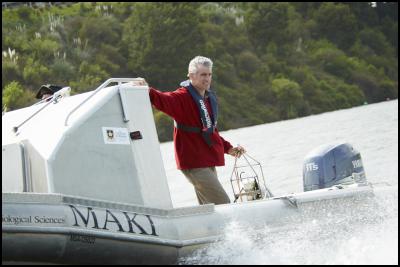Getting on top of toxin production
Wednesday 31 October,
2012
Getting on top of toxin production

University of Waikato ecologist Professor David Hamilton has been awarded a $920,000 Marsden Grant to study toxin production found in blue-green algae in lakes.
His research project is titled “Toxic in crowds: the triggers of toxin production in planktonic cyanobacteria”. Cyanobacteria are commonly called blue-green algae. Some species can produce potent toxins which affect humans through drinking water or contact recreation, as well as other organisms that live in the water. Blue-green algae are stimulated to grow and form blooms by increasing levels of nutrients.
Recent records of increases in nutrient loads to lakes are therefore of particular concern, both from an environmental point of view and for human health considerations. Professor Hamilton and his colleagues, including Dr Susie Wood from Cawthron in Nelson, have found that when blue-green algae congregate into dense blooms they can rapidly ramp up the rate of toxin production. “This project will try to understand why blue-green algae produce toxins and what specific triggers make the blue-green algae increase toxin production when they form blooms.”
Professor Hamilton is one of six Waikato academics who received Marsden Grants totalling $3.6 million in the latest round of funding, which is administered by the Royal Society of New Zealand on behalf of the Marsden Fund Council, and funded by the New Zealand Government.
He has been researching aspects of water quality for more than 20 years and is currently part of a team that is trialling an aeration device on Lake Rotoehu, pumping oxygen into the water to counteract the harm done by nutrients and sediment that have leached or run off into the lake.
“Blooms of blue-green algae are increasing across the globe and scientists are trying to understand why. One culprit may be intensification of agricultural land leading to more nutrients to fuel blooms of blue-green algae. Another may be climate change since many lakes across the globe have warmed by 1-2 degrees Celsius over the past two decades; even more rapidly than increases in air temperature.”
Blue-green algae are favoured by higher temperatures because they originate from bacteria which grow more rapidly than other algae at elevated temperatures. The Marsden funding will help to identify both the causes of blue-green algal blooms and the relationship of blooms to toxin production. “Ultimately it is hoped that the outcomes of the project will improve knowledge of how to manage the occurrence of blue-green algal blooms and avoid the possibility of toxin production by them.”
Professor Hamilton, the Bay of Plenty Regional Council Chair in Lake Restoration, also works internationally sharing information with researchers from other countries as they seek long-term solutions that can be applied to any freshwater lake system.
He is chief scientist for Lake Ecosystem Restoration New Zealand (LERNZ) - a ten-year $10 million initiative to identify and remediate threats to lake ecosystems. Through LERNZ computer models are being developed that can be used for prediction and management, and the model outputs are being adopted by regional councils and policy makers to assist in future planning of lake restoration.
“Our LERNZ group also has buoys in nine lakes in New Zealand, China and Singapore that send out readings every fifteen minutes, so we’re getting immediate and accurate information and can respond quickly if we see dramatic changes in water quality. The benefit to working internationally is that you can collate data, share information, knowledge, software and hardware amongst like-minded scientists across the globe.” Related to this, Professor Hamilton was one of the founding members of GLEON, the Global Lakes Ecological Observatory Network, which now has more than 350 members worldwide who are making high-frequency measurements in lakes.
This year, Professor Hamilton won the environmental scientist category at the Waikato Kudos Awards held to acknowledge scientific achievement.
ENDS


 Bill Bennett: Download Weekly - Starlink direct-to-mobile passes US regulatory hurdle
Bill Bennett: Download Weekly - Starlink direct-to-mobile passes US regulatory hurdle Plumbers Gasfitters and Drainlayers Board: Plumbers, Gasfitters And Drainlayers Board Drops ‘Journeyman’ And ‘Tradesman’ Names
Plumbers Gasfitters and Drainlayers Board: Plumbers, Gasfitters And Drainlayers Board Drops ‘Journeyman’ And ‘Tradesman’ Names ERANZ: Electricity Saving Coaching Service To Launch In Wairoa
ERANZ: Electricity Saving Coaching Service To Launch In Wairoa SolarZero Affected Staff: SolarZero Staff Are Demanding Answers After The Company Went Into Liquidation
SolarZero Affected Staff: SolarZero Staff Are Demanding Answers After The Company Went Into Liquidation Tātau Tātau O Te Wairoa: Guidance To Save Local Newspapers Amid NZME Closures
Tātau Tātau O Te Wairoa: Guidance To Save Local Newspapers Amid NZME Closures Commerce Commission: Systemic Breaches Of Consumer Law Lead To $1.5million Fine For Kiwibank
Commerce Commission: Systemic Breaches Of Consumer Law Lead To $1.5million Fine For Kiwibank



